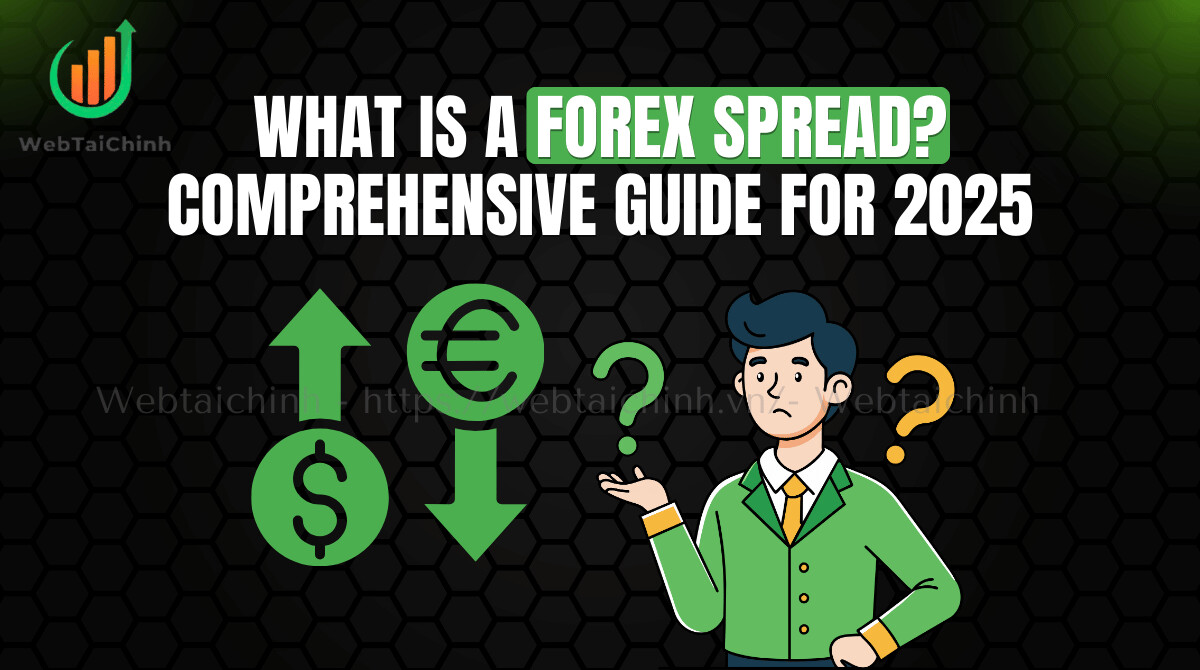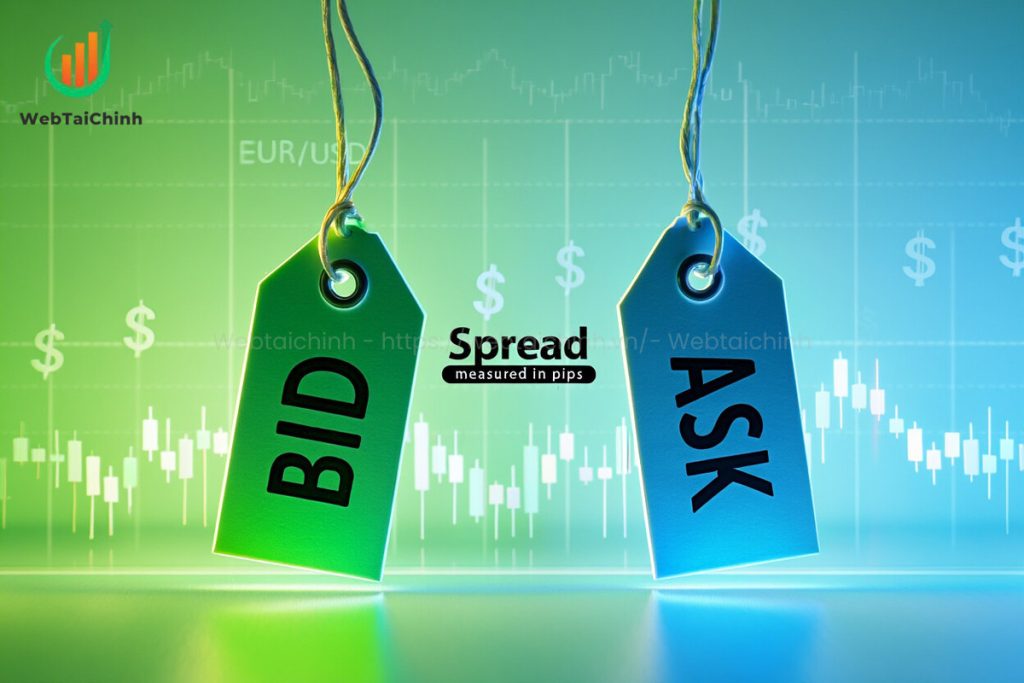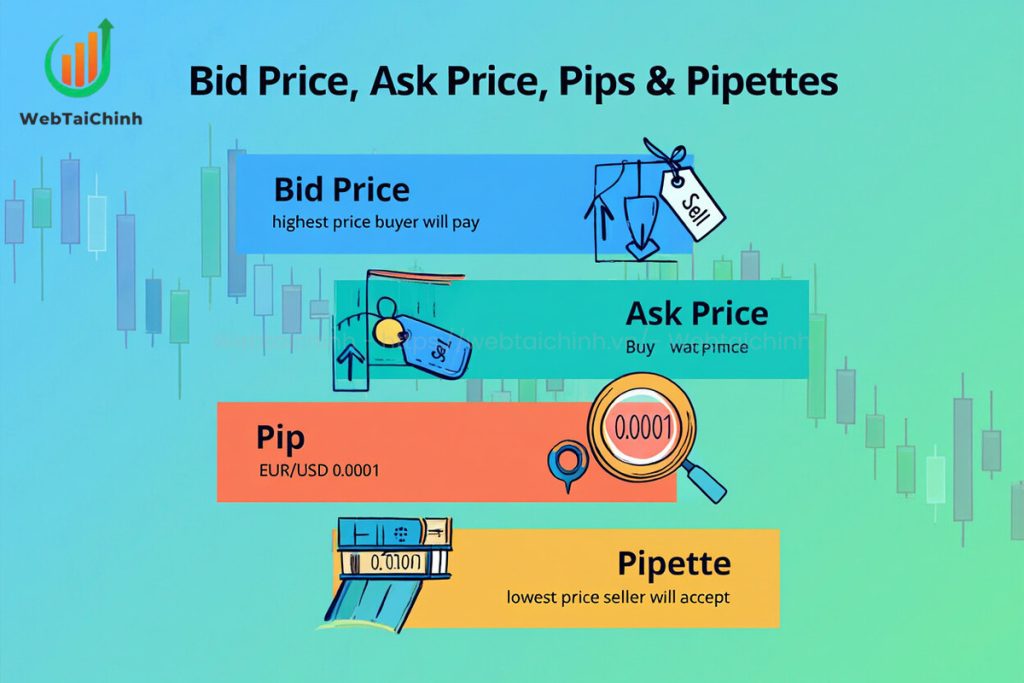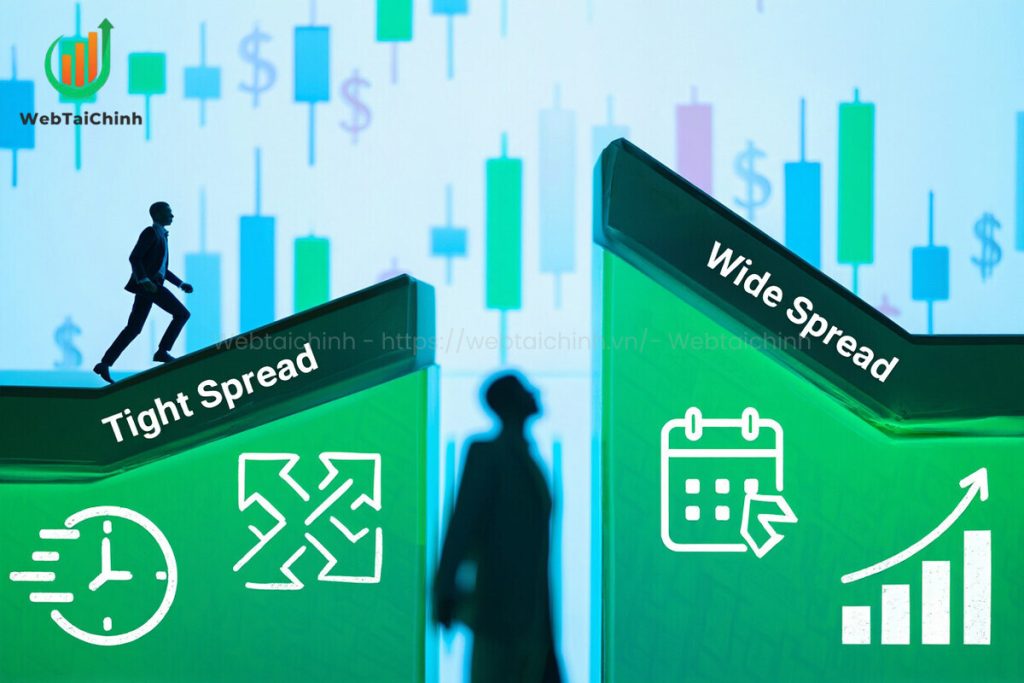Physical Address
304 North Cardinal St.
Dorchester Center, MA 02124
Physical Address
304 North Cardinal St.
Dorchester Center, MA 02124

What is a forex spread and why does it matter for traders? A forex spread is the gap between the bid and ask price, and it’s one of the most important costs you’ll face in trading. Understanding it helps you avoid hidden fees, choose the right broker, and make more profitable trades. Many beginners ignore spreads, only to see profits eaten away by trading costs.
In this guide, Webtaichinh will break down what forex spreads are, how they work, and the smartest ways to reduce them so you keep more of your gains.
A forex spread is the difference between the bid price (the price at which you can sell a currency pair) and the ask price (the price at which you can buy it). This gap is measured in pips the smallest unit of price change in the forex market and represents one of the primary costs of trading.

For example, if the EUR/USD pair has a bid price of 1.1200 and an ask price of 1.1205, the spread is 5 pips. Every time you open a trade, you pay this cost indirectly, as the market must move in your favor by at least the size of the spread before you can break even.
The forex spread is crucial because it:
Directly affects trading costs and potential profits.
Varies by currency pair, broker type, and market conditions.
Plays a bigger role in high-frequency strategies like scalping, where even small differences in spread can impact results significantly.
To fully understand what is a forex spread, you need to know the key components that make it up:
Bid price – The highest price a buyer is willing to pay for a currency pair. This is the price you sell at.
Ask price – The lowest price a seller is willing to accept. This is the price you buy at.
Pip – The smallest standard price movement for most currency pairs, usually located at the fourth decimal place (0.0001). For example, in EUR/USD, a change from 1.1200 to 1.1201 equals 1 pip.
Pipette – A fractional pip, equal to one-tenth of a pip, shown at the fifth decimal place (e.g., 0.00001). Pipettes give traders more precise pricing.

Example:
For EUR/USD, a broker quote might show 1.12004 / 1.12009. The difference is 0.00005, or 0.5 pips. For JPY pairs like USD/JPY, the convention is different they are quoted to two decimal places (e.g., 110.00 / 110.05), where 0.05 equals 5 pips.
Understanding these terms helps you read broker quotes correctly and instantly recognize the cost of entering a trade.
If you’re learning what is a forex spread in practical terms, here’s the calculation process:
Formula:
Then, convert the result into pips based on the currency pair’s decimal convention.
Example 1 – EUR/USD:
Ask price = 1.1205
Bid price = 1.1200
Difference = 0.0005
Since 1 pip = 0.0001 for most major pairs, 0.0005 ÷ 0.0001 = 5 pips
Example 2 – USD/JPY:
Ask price = 110.05
Bid price = 110.00
Difference = 0.05
Since 1 pip = 0.01 for JPY pairs, 0.05 ÷ 0.01 = 5 pips
Pro tip: For quick mental calculation, just subtract the bid from the ask and match the pip definition for that currency pair. Many brokers also display the spread directly on the trading platform, saving you the math.
Part of understanding what is a forex spread is knowing why it changes:

Type of currency pair
Major pairs (EUR/USD, GBP/USD, USD/JPY) have tighter spreads due to higher trading volume and liquidity.
Exotic pairs (USD/TRY, EUR/ZAR) have wider spreads because of lower liquidity and higher volatility.
Market news and volatility
Economic announcements like interest rate decisions or Nonfarm Payrolls can cause spreads to widen sharply.
High volatility means brokers face more risk, which they offset by increasing the spread.
Trading hours
Spreads are usually tighter during peak trading sessions (London and New York overlaps).
They widen during off-hours, such as the Asian late session or weekends, when liquidity is lower.
Broker type and pricing model
Market makers may offer fixed spreads but can widen them during extreme volatility.
ECN/STP brokers pass through raw spreads from liquidity providers but charge commissions instead.
Understanding these factors helps you anticipate spread changes and choose trading times, pairs, and brokers more strategically.
The more you know about what is a forex spread, the better you can control costs. It affects both your breakeven point and your overall profitability.

When you open a trade, you immediately start with a small loss equal to the size of the spread. For example, if the EUR/USD spread is 5 pips, the market must move 5 pips in your favor before you break even.
Tighter spreads → You reach breakeven faster.
Wider spreads → You need larger price moves to cover the cost.
Scalpers & day traders: Wide spreads can quickly eat into profits when executing multiple trades per day.
Swing & position traders: The impact of spread is smaller relative to overall trade size, but it still matters for optimal entry and exit points.
Example: Trading 1 standard lot of EUR/USD with a 5-pip spread costs around $50 (5 pips × $10 per pip). If you make 10 trades a day, that’s $500 in spread costs alone.
Reducing your spread expenses can significantly improve your trading results, especially for active traders. If you know what is a forex spread and how it’s calculated, you can reduce it by:
Trade during peak liquidity hours
Overlap between the London and New York sessions generally offers the tightest spreads.
Focus on major currency pairs
Majors like EUR/USD or USD/JPY naturally have smaller spreads than exotic pairs.
Compare brokers’ average spreads
Don’t just look at the minimum spread they advertise check historical averages during different times of the day.
Avoid trading during high-impact news releases
Major economic announcements can cause spreads to spike temporarily.
Consider limit orders over market orders
Limit orders can help you enter at a more favorable price without instantly paying the spread.
By combining these tactics, you can keep trading costs low and protect your profit margins over time.
Learning what is a forex spread also means knowing its types:

Definition: A spread that remains constant regardless of market conditions.
Pros: Predictable trading costs, easier to plan strategies.
Cons: Often set higher than the average variable spread during normal conditions; may still widen in extreme volatility.
Best for: Beginners or traders who value cost certainty over potentially lower costs.
Definition: Spreads that fluctuate based on market liquidity and volatility.
Pros: Often lower than fixed spreads during calm market periods.
Cons: Can widen significantly during high-impact news events or low liquidity.
Best for: Experienced traders who can manage the risk of spread fluctuations.
Brokers generally use one of two pricing models:
All-in spread: The commission is included in the spread. Simple to understand but can result in slightly wider spreads.
Raw spread + commission: Spreads are very tight (sometimes close to zero) but you pay a separate commission per lot. This can be cheaper overall, depending on trade size and frequency.
Example:
All-in account: EUR/USD spread = 1.5 pips, no extra commission → cost = $15 per standard lot.
Raw spread + commission: EUR/USD spread = 0.5 pips + $7 commission → cost = $12 per standard lot.
A good forex spread is usually 1–2 pips for EUR/USD and GBP/USD, and 1–3 pips for USD/JPY during normal market conditions.
The forex spread widens during major economic news, unexpected market events, or low-liquidity periods like market open, close, or holidays.
Yes, zero-spread accounts exist but often include higher commissions or specific conditions. Always check the broker’s credibility and fee structure.
For most retail traders, the forex spread stays constant. Very large trades may trigger wider spreads due to reduced liquidity.
This happens during low liquidity hours, high-impact news events, or extreme market volatility.
Understanding what is a forex spread is one of the most important skills for any trader. The forex spread directly influences your trading costs, breakeven levels, and long-term profitability.
In this guide, we’ve covered:
The differences between fixed and variable spreads, and how they compare to commission-based pricing.
Mastering these concepts will help you choose better brokers, execute trades more effectively, and keep more of your profits.
Web Tai Chinh is a portal that updates news and information related to finance quickly and accurately, helping users have an overview before investing, clearly understanding concepts and terms related to Finance. Explore more insights in our Forex category, start your FX trading journey today with the right partner for long-term success.
📞 Contact: 055 937 9204
✉️ Email: webtaichinhvnvn@gmail.com
📍 Address: 13 Ho Tung Mau, An Binh, Di An, Binh Duong